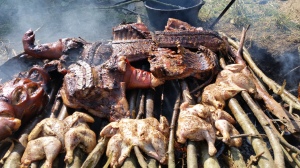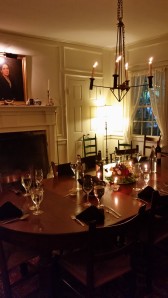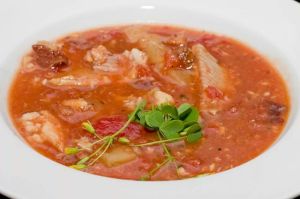Mike Moore is the best. (And his family recipe for cucumber salad is killer.)

That’s not really the thesis of this blog post, but it has to be said. Mike, chef-proprietor of Seven Sows Bourbon and Larder in Asheville, heard my call for dialogue and culinary justice and reconciliation and opened up the door and did it in a big way. He understands that The Cooking Gene is not a pipe dream, its a way of re-thinking about Southern food and Southern food history and culture–a dialogue built on mutual understanding. He invited me to cook for a special event for Blind Pig, a showcase for local and guest chefs that does good work in the community by donating part of the proceeds to local charities. These dinners sell out —-fast. Another headliner was chef Elliott Moss, who is going to be opening Buxton Hall Barbecue in Asheville. We were joined by Jeff “Rhino” Bannister of Bovinoche whose expertise would prove to save the day.
He invited me to share my recipes and a menu and from that we created a feast:

The dinner was held at Sherill’s Inn, an antebellum inn/tavern in Fairview, NC, not far from Asheville. Sherill’s was located on the Drover’s Road, which brought livestock, especially pigs to pork, to and fro from the Appalachians to the Lowcountry. It’s a very steep, hilly, uneven but gorgeous spot and you couldn’t as for better views for a farm in Western North Carolina (cue reader mail).

The day before the Blind Pig event, we
went into the woods near the inn and felled eight sapling trees. Young oak, cherry, sassafras and tulip poplar came down. Elliott and Mike dug a pit that was about 3 feet deep and about 6 feet long. The stakes were tested to see if they would work, then soaked overnight. In the morning, we came to light the fire, but a mountain storm soaked our wood as the fire was being stoked. We were destined to be three hours behind.
When life sends you rain, call Jeff Bannister. Jeff is used to finding ways to roast large amounts of meat. He does it every year at event he hosts called Bovinoche where he grills whole cows and makes giant paellas. Jeff borrowed the leaf blower from the farm which although, decidedly not period, set my half-cord of wood ablaze. From that moment on, we were good. We steamed the cuts of meat in cast iron pots then put them on our sapling grill and cooked them for six hours over a red oak fire enhanced by oak shavings and hickory chunks.


At the end of the day, it was a great success. The setting was beautiful, the food was great and the people packed it in—we had over 90 participants! Sweet potatoes cooked with sorghum molasses, butter and spiced rum; crunchy fried chicken done in the manner of Rufus Estes in a vegetable brine laced with kitchen pepper then finished off with a lacing of honey, herby and oniony cornbread kush full of rich texture and mouthfeel and catfish stew with a savory base so complex it coated your tongue. And…barbecue…..wow–you’ve just got to bring me out to see how good it tastes in your neighborhood!


These Southern Things: A Menu Musing by Historical Chef and Culinary Historian—Michael W. Twitty
When Mike Moore asked me to come do a meal in reflective of Southern cuisine’s complex history and culinary narratives I jumped at the opportunity to work alongside professional chefs to share knowledge, skills and traditions from across the centuries. My own work began as a matter of curiosity with a simple question: How did the food of the past actually taste? That question led to another question: Did our tastes change; and as they changed did they shape our history? That query led to the ultimate mission for me as I searched time, space and taste: How was my destiny shaped by the story of Southern food?
This menu you’re enjoying tonight is reflective of tastes in transition and the movement of flavors between worlds that up until about the year 1492, had remained relatively isolated and deceivingly static. On your plates we have Native American, African and Eurasian ingredients. None are without their complexities and complex connections. The type of cookware, the cook, the ingredients, the recipe, the culinary grammar and the socio-political-economic context are the variables. Plug in any of those groups and the outcomes multiply. Somewhere in that murkiness of lives lived and lost in the Chesapeake and Tidewater, Lowcountry, Backcountry, Gulf Coast and Lower Mississippi Valley lie the gestation of proto-Southern foodways.
The real history is not in the food, it’s in the people. My alternative to traditional Southern foodways history is to tell you about the real power of these recipes as they migrate like souls from life to life and generation to generation. They search for new life even as they age and rage against the darkness of cultural and culinary amnesia. For people of color in the South, especially those of African descent, this story is especially true. We are working against the loss of our cultural memory, against the consequences of institutional oppression, against indiscriminate and flagrant appropriation and courts of public opinion that question our authenticity, maturity and motives in the revolutionary act of clarifying and owning our past.
My ancestors were West, Central and Southeastern African. They included some of humanities first cooks. DNA research tells me that they were from Senegambia, Sierra Leone, Ghana, Nigeria, Benin, Congo-Angola and Mozambique. They were rice growing Mende and yam growing Igbo, Ewe and Akan, cassava eating Kongo and millet eating Wolof and Fon. Science, history, statistics, genetics, culture, food, and the culinary arts bring me closer and closer to these Southern ancestors. They were my forebears but truly they were yours as well.
And yet I am European, Middle Eastern and Native American as well. These are my stories and yours. We are connected as a Southern family not just by circumstance but by recipes and blood. Our family will continue to expand just as the South will expand its arms wider to incorporate new people, new foods and new bloods into its family tree. Not the least of “these Southern things,” are our faith that the South will endure—not merely despite the shadow of its past, but as a dynamic tradition built on family and sacred grounds, of problems stated in terms of race, class, status and spirit, and solved in terms of the miracles and mysteries of food, to quote Mark Twain, so good we grieve for the angels “for they have it not.”
CATFISH STEW
Catfish are a true “soul food.” Massive catfish are found in the rivers of West Africa and the Southeastern United States, and their presence must have been a familiar site to many West African fishermen. Many West African cultures relished them, including the cultures of Upper Guinea—catfish bones were found at Jenne-Jeno, one of the most ancient cities in Old Mali. Catfish are found represented in art in Lower Guinea—as brass weights and other decorative forms. Not all cultures that came to the early South ate catfish; among some Mande, it is taboo to eat the catfish because it was sacred to their ancestors. In some places it is smoked whole and used as a flavoring agent to add umami pungency to soups and stews. In the South during the mid 19th century, several catfish—the blue catfish, the channel cat, yellow and brown bullheads and the white catfish would have been caught in the creeks and tributary rivers as well as sea catfish—gafftopsails from the ocean in the Carolina and Georgia Lowcountry. Here is a catfish stew made from ingredients commonly found in the antebellum quarters.
a few wild onions, thinly sliced, greens, bulb and all
1 cup of salt pork, cubed (you can substitute thick country bacon or pancetta)
1 cup of diced white potatoes or white sweet potatoes
2-3 chopped ripe heirloom tomatoes (canned will work)
1 crushed fish or long cayenne pepper, or you can substitute a tablespoon of fish pepper hot sauce
1 teaspoon of kitchen pepper (see below)
salt
water to cover
3 catfish, skinned and cleaned, or fillets cut up into small pieces
Fry the wild onions and salt pork together until the onions are soft and translucent. Add the potatoes and tomatoes and keep sautéing a few more minutes. Add the kitchen pepper, crushed pepper and salt and add water to cover. Stew together for 30 minutes. Add the catfish and stew together more for 10 more minutes until the meat flakes.
Elliott Moss tip: garnish with sheep sorrel sprigs for a slightly pungent, sour, pop.
Kitchen pepper..mix to your taste..Black pepper, white pepper, red pepper, cinnamon, mace, nutmeg, etc.
Thank YOU: Michael and Darlene Moore, Sherill’s Inn, Elliott Moss, Jeff Bannister, Helen Hollyman, J. F. Wyndello, Cindy Kunst (the good shots are all hers!), Jennifer, Alan Muscat, Jonathan Ammons, Keia Mastrianni, Tonya Russ Price, Denny Trantham, and all the wonderful chefs and foodies of Asheville, who gave me a real education!
You are so cool. I really enjoy reading your articles. Shana Brown-Black
LikeLike
Michael- What a pleasure it was to share a table with you. Thank you for your contributions and thought-provoking conversation. Here’s hoping we can continue them around another table very soon!
LikeLike
Thank you for your kind words. It was great cooking with you. Still dying to get that rub recipe for the pork that came from the family in Spartanburg.
LikeLike
Michael, on this night of ‘These Southern Things’ ~ you asked us to pause and think of the hardships and sacrifices many of our ancestors endured–powerful and evocative. Thank you.
LikeLike
Michael, on this night of ‘These Southern Things’ ~ you asked us to pause and think of the hardships and sacrifices many of our ancestors endured–powerful and evocative. Thank you.
LikeLike